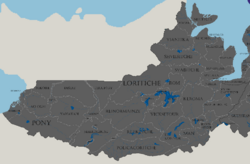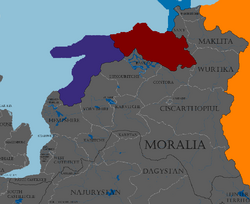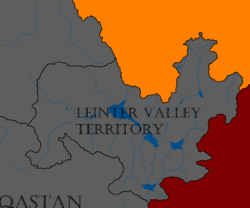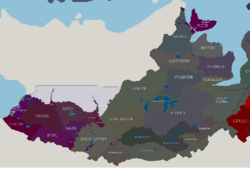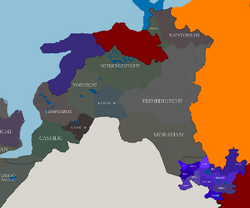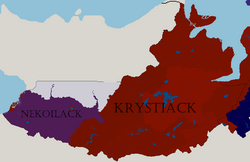Diutche
| This was made by Dakota Territories, and this is my primary RP nation on Strangereal, a TNP (NS) RMB map. I hope you have a good read. |
The Grand Kingdom of Diutche Grōß Kōenigrejik von Diutche Kingdom of Kingstar | |||||||||||||||||||||||||||||||||||||||||||||||||||||||||||||||||||||||||||||||||||||||||||||||||||||||||||||||||||
|---|---|---|---|---|---|---|---|---|---|---|---|---|---|---|---|---|---|---|---|---|---|---|---|---|---|---|---|---|---|---|---|---|---|---|---|---|---|---|---|---|---|---|---|---|---|---|---|---|---|---|---|---|---|---|---|---|---|---|---|---|---|---|---|---|---|---|---|---|---|---|---|---|---|---|---|---|---|---|---|---|---|---|---|---|---|---|---|---|---|---|---|---|---|---|---|---|---|---|---|---|---|---|---|---|---|---|---|---|---|---|---|---|---|---|---|
| |||||||||||||||||||||||||||||||||||||||||||||||||||||||||||||||||||||||||||||||||||||||||||||||||||||||||||||||||||
The Kingdom of Östendiutche Kōenigrejik von Östendiutche | |||||||||||||||||||||||||||||||||||||||||||||||||||||||||||||||||||||||||||||||||||||
|---|---|---|---|---|---|---|---|---|---|---|---|---|---|---|---|---|---|---|---|---|---|---|---|---|---|---|---|---|---|---|---|---|---|---|---|---|---|---|---|---|---|---|---|---|---|---|---|---|---|---|---|---|---|---|---|---|---|---|---|---|---|---|---|---|---|---|---|---|---|---|---|---|---|---|---|---|---|---|---|---|---|---|---|---|---|
| |||||||||||||||||||||||||||||||||||||||||||||||||||||||||||||||||||||||||||||||||||||
The Leinter Valley Territory Kär Istahe Kant | |||||||||||||||||||||||||||||||||||||||||||||||||||||||||||||||||||||||||||||||
|---|---|---|---|---|---|---|---|---|---|---|---|---|---|---|---|---|---|---|---|---|---|---|---|---|---|---|---|---|---|---|---|---|---|---|---|---|---|---|---|---|---|---|---|---|---|---|---|---|---|---|---|---|---|---|---|---|---|---|---|---|---|---|---|---|---|---|---|---|---|---|---|---|---|---|---|---|---|---|---|
| |||||||||||||||||||||||||||||||||||||||||||||||||||||||||||||||||||||||||||||||
The Republic of Bejaşerastan Bejaşerastan | |||||||||||||||||||||||||||||||||||||||||||||||||||||||||||||||
|---|---|---|---|---|---|---|---|---|---|---|---|---|---|---|---|---|---|---|---|---|---|---|---|---|---|---|---|---|---|---|---|---|---|---|---|---|---|---|---|---|---|---|---|---|---|---|---|---|---|---|---|---|---|---|---|---|---|---|---|---|---|---|---|
| |||||||||||||||||||||||||||||||||||||||||||||||||||||||||||||||
The Grand Kingdom of Diutche is a Semi-constitutional Monarchy, with Grand King Astro Skovi and Prime Minister Maria Von Swede as the heads of state. Diutche uses a system of checks and balances, whereas the King can send in bills for parliament and Veto bills passed by the parliament, and the Parliament can veto the Grand Kings military initiatives or his bills he introduces into the parliament.
The nation has a few neighbors, that being Östendiutche to the east, and Sarcaritche and Harl-Ombragen •Archiac: Gothika through the Leinter Valley Territory. Through Östendiutche, the nation borders the The Östenrejiker-Duestchen Union,Britanitche, Sarcaritche, and Harl-Ombragen
Etymology
The common name, ‘Kingstar’ comes from the nations capital, Kingstar. Kingstar is the strangrealic literal translation of the name Kōenigsterne, which derives from the term "Tros 'Kōenigse' Von Tehs 'Sternēs'", or The King of the stars. The Grand Kingdom of Diutche, the country that the Kingstar Kingdom is subservient to, comes from the word ‘people’ in Diutchelies, whereas Östendiutche means East Diutche, or Eastern People. The letters -liche typically denotes people of a country, as in Diutcheliche or Östeliche, and conversely, -itche denotes a land of a people, typically a state within a country, but is sometimes found in nation names in Diutchelies. The -lies is a suffix meaning ‘speak’, meaning Östelies means East(ern) speak (speech) and Diutchelies means Diutche (People) speak (speech).
History
The Era of Migrations
In the standard Strangrealic year of 141 BCE, the land known as Diutche had begun seeing migrations of Germanic tribes from the east, from Östendiutche, and from the southern mountains. The original inhabitants were the Nekoilites, a large ethnic group consisting of humans with catlike features, such as ears and tails. Originally the majority, the Nekoilites were gradually overtaken by the Germanic tribes, which would later begin to merge and form the protodiutcheliche population in 128ce. By 216ce, the eastern portion of the region was fully Germanised, where the Nekoilite population were either assimilated into minority groups, or pushed out entirely. By this time, many states had begun forming out of tribes and begun expanding. The two most prominent were the Starcian petty kingdom in the east, and the Nekoilite Shojogate in the west.
Consolidation of States
Being the two largest states in the region, it created a large rivalry between the two states. By 221ce, the west and east respectively fell into their dominion, where tensions would boil over and the first war between the two countries, and the first major conflict to befall the region, would begin.
The First Starcian-Shojogate War
During the early spring of 225 CE, the Nekoilite King, Nǎsir Atuk, died of pneumonia, leaving his young son, Masǔr, as the next King. Sensing weakness, the Starcian king, Astolf von Holz, ordering raids along the border. These raids devastated the countryside, killing many and forcing more to flee inwards. Angered, Masǔr took action, and declared war on Starcia.
Soon thereafter, the river city of Kvarsel (now Kvarburg, Svabitche) discovered an approaching Starcian army, and sent a message to the nearby military encampment. In order to prevent the capture of another settlement, the 2nd Nekoilite legion was sent, and arrived in 2 days.
Language
The Diutche language, Diutchelies, has 3 genders and 4 cases. Like its many Germanic counterparts, there is not a set word order for the cases (there is a rigid word order for things such as adjectives, adverbs, and the like). The three genders are Feminine, Masculine, and Neuter, while the cases are Nominative (Subject), Accusative (Direct Object), Genitive (Possession), and Dative (Indirect Object). Now, when discussing crowds of people, or things of unknown gender, the neuter case is used, in place of feminine or masculine singular and plural declensions.
Geography
Climate
Environment
Politics and Government
Military
Foreign Relations
Economy
Energy
Industry
Infrastructure
Transport
Demographics
The people of Kingstar are of multiple cultures, ethnicities, and some local faiths. Issues like LGBTQ is completely legalized by the federal government, along with local state religions differing from the national religion.
Population
Diutche
| Rank | City | Metropolitan Area Population | Majority Culture | Majority Religion | Province |
|---|---|---|---|---|---|
| 1 | Starkia | 5.2 million | Starkian | Krystiack | Starkia |
| 2 | Kingstar | 3.7 million | Skovin | Krystiack | Kingstar Federal District |
| 3 | Conthich | 3.1 million | Neïte | Krystiack | Neïtitche |
| 4 | Barok | 3 million | Mittles-Starkian | Krystiack | Ancourson |
| 5 | Magenburg | 2.8 million | Svediche | Krystiack | Magenburg |
| 6 | Vurtemburg | 2.6 million | Mittles-Starkian | Krystiack | Handova |
| 7 | Kölin | 2.6 million | High Devite | Krystiack | Malbergburg |
| 8 | Anschbaren | 2.2 million | Starkian | Krystiack | Starkia |
| 9 | Vën | 2.1 million | Neïte | Krystiack | Neïtitche |
| 10 | Aëchen | 1.9 million | Domican | Nekïolack | Undekour |
| Ethnic Group | Culture | Population (Million) | (First) Language | Religion |
|---|---|---|---|---|
| Diutcheliche | Skovin | 8.4 | 100% Diutchelies | Krystiack |
| Diutcheliche | Karien | 4 | 42% Karienlies, 12% Starklies, 46% Diutchelies | Krystiack |
| Diutcheliche | Starkian | 10.4 | 46% Starklies, 53% Diutchelies | Krystiack |
| Diutcheliche | High Icocan | 2.3 | 63% Icocalies, 37% Diutchelies | Krystiack |
| Diutcheliche | Low Devite | 5.8 | 64% Divoilies, 36% Diutchelies | Krystiack |
| Diutcheliche | High Devite | 5.1 | 78% Divoilies, 22% Diutchelies | Krystiack |
| Diutcheliche | Lorite | 5.4 | 61% Lorlies, 12% Divoilies, 4% Starklies, 23% Diutchelies | Krystiack |
| Diutcheliche | Mittles-Starkian | 7.3 | 63% Starklies, 37% Diutchelies | Krystiack |
| Diutcheliche | Schviesen | 2.5 | 22% Schvielies, 78% Diutchelies | Krystiack |
| Diutcheliche | Svabiche | 4.5 | 12% Starklies, 24% Shvielies, 34% Diutchelies | Krystiack |
| Diutcheliche | Svediche | 6.2 | 32% Starklies, 68% Diutchelies | Krystiack |
| Diutcheliche | Vestioc-Castilic | 6.7 | 32% Castilies, 68% Diutchelies | Krystiack |
| Diutcheliche | Kareische | 1.8 | 53% Menscher, 47% Diutchelies | Krystiack |
| Diutcheliche | Maniliche | 4.9 | 82% Menscher, 18% Diutchelies | Krystiack |
| Diutcheliche | Konick Icocan | 2.4 | 54% Icocalies, 46% Diutchelies | Krystiack |
| Diutcheliche | Rejike Icocan | 1.6 | 73% Icocalies, 27% Diutchelies | Krystiack |
| Diutcheliche | Polich-Baska | 1.6 | 63% Polies, 34% Baskalies, 3% Diutchelies | Krystiack |
| Neïte-Diutcheliche | Skoïte | 3.6 | 34% Skïlies, 21% Neïlies, 45% Diutchelies | Krystiack |
| Nekoilite | Neïte | 10.1 | 100% Neïlies | Krystiack |
| Nekoilite | Bari | 0.7 | 100% Divoilies | Krystiack |
| Nekoilite | Neko | 1.7 | 100% Divoilies | Krystiack |
| Nekoilite | Veru | 1.4 | 100% Divoilies | Krystiack |
| Nekoilite | High Baren | 0.6 | 100% Barrik | Nekïolack |
| Nekoilite | Mittles-Baren | 1.2 | 100% Barrik | Nekïolack |
| Nekoilite | Low Baren | 1.5 | 100% Barrik | Nekïolack |
| Nekoilite | Mari | 1.3 | 42% Ianï, 37% Pontchï, 21% Oskï | Nekïolack |
| Nekoilite | Iano | 6.1 | 73% Ianï, 27% Oskï | Nekïolack |
| Nekoilite | Drinn | 1.4 | 26% Divoilies, 74% Pontchï | Nekïolack |
| Nekoilite | Myri | 1.9 | 100% Myrï | Nekïolack |
| Nekoilite | Ponï | 4.2 | 81% Pontchï, 12% Oskï, 7% Nakï | Nekïolack |
| Nekoilite | Oscha | 5.6 | 93% Oskï, 7% Domican | Nekïolack |
| Nekoilite | Nachil | 3.1 | 63% Nakï, 28% Domican, 9% Oskï | Nekïolack |
| Nekoilite | Poys | 1.7 | 11% Poï, 70% Domican, 19% Oskï | Nekïolack |
| Nekoilite | Domican | 7.2 | 89% Domican, 11% Oskï | Nekïolack |
Östendiutche
| Ethnic Group | Culture | Population (Million) | (First) Language | Religion |
|---|---|---|---|---|
| Diutcheliche | Vestioc-Castilic | 2 | 21% Castilies, 43% Diutchelies, 36% Östelies | Krystiack |
| Östeliche | Castilic | 7.6 | 32% Castilies, 68% Östelies | Krystiack |
| Östeliche | Hempshirite | 5.9 | 24% Castilies, 27% Hymlies, 49% Östelies | Krystiack |
| Östeliche | Kaisiche | 1.2 | 12% Castilies, 43% Hymlies, 45% Östelies | Krystiack |
| Östeliche | Yorviche | 3.5 | 42% Hymlies, 68% Östelies | Krystiack |
| Östeliche | Neiderdiutche | 12.9 | 72% Neiderlies, 28% Östelies | Krystiack |
| Östeliche | Karviche | 5.4 | 14% Neiderlies, 12% Hymlies, 74% Östelies | Krystiack |
| Östeliche | Saxic | 2.1 | 86% Saxlies, 11% Balstoner 3% Östelies | Krystiack |
| Östeliche | Balstonian | 6 | 32% Balstoner, 68% Östelies | Krystiack |
| Östeliche | Ebendiutche | 12 | 100% Östelies (Ebenlies) | Krystiack |
| Östeliche | Moralian | 7.8 | 57% Moraler, 43% Östelies | Krystiack |
| Tieermanschen | Val | 0.6 | 100% Northern Tierrmanschelies | Tieeranimalism |
Leinter Valley
| Ethnic Group | Culture | Population (Million) | (First) Language | Religion |
|---|---|---|---|---|
| Tieermanschen | Val | 0.3 | 100% Northern Tieermanschelies | Tieeranimalism |
| Tieermanschen | Neisin | 1.1 | 100% Northern Tieermanschelies | Tieeranimalism |
| Tieermanschen | Mui | 0.6 | 100% Northern Tieermanschelies | Tieeranimalism |
| Tieermanschen | Lieri | 1.4 | 100% Northern Tieermanschelies | Tieeranimalism |
| Tieermanschen | Niumi | 0.9 | 100% Western Tieermanschelies | Tieeranimalism |
| Tieermanschen | Itya | 0.4 | 100% Western Tieermanschelies | Tieeranimalism |
| Tieermanschen | Bui | 0.8 | 100% Eastern Tieermanschelies | Tieeranimalism |
| Tieermanschen | Thropen | 2.1 | 100% Central Tieermanschelies | Tieeranimalism |
| Tieermanschen | Genhsen | 1.4 | 100% Central Tieermanschelies | Tieeranimalism |
| Tieermanschen | Hera | 0.9 | 100% Central Tieermanschelies | Tieeranimalism |
| Tieermanschen | Niami | 1.2 | 100% Southern Tieermanschelies | Tieeranimalism |
| Tieermanschen | Lycan | 1.9 | 100% Eastern Tieermanschelies | Tieeranimalism |
Bejaşerastan
| Ethnic Group | Culture | Population (Million) | (First) Language | Religion |
|---|---|---|---|---|
| Diutcheliche | Manliche | 2.1 | 100% Menscher | Krystiack |
| Diutcheliche | Vestioc-Castilic | 4.1 | 78% Castilies, 22% Diutcheliche | Krystiack |
| Östeliche | Castilic | 1.3 | 100% Castilies | Krystiack |
| Östeliche | Kaisiche | 0.7 | 100% Hymlies | Krystiack |
| Östeliche | Karviche | 1.6 | 100% Hymlies | Krystiack |
| Östeliche | Moralian | 1.2 | 100% Moraler | Krystiack |
| Bejaşeri | Gulei | 8 | 65% Gulei, 35% Bejaşeri | Twin Oracles |
| Bejaşeri | Najure | 12.8 | 37% Najurei, 63% Bejaşeri | Twin Oracles |
| Bejaşeri | Dage | 10.1 | 42% Dagei, 58% Bejaşeri | Twin Oracles |
| Bejaşeri | Dayhanlar | 11.6 | 76% Dayhanlai, 24% Bejaşeri | Twin Oracles |
| Bejaşeri | Bejiqati | 16.8 | 98% Bejaşeri, 2% Dage | Twin Oracles |
| Bejaşeri | Sergasi | 5.7 | 9% Sergasi, 91% Bejaşeri | Twin Oracles |
Religion
The majority religion in Diutche and Östendiutche is Kystiack, which is an Orthodox Trinitist faith. The religion is split into multiple metropolitan areas, which have been approved by the Patriarch. Currently, Diutche holds the Patriarchy proper, and Östendiutche holds a the Lesser Patriarchy, also known as a High Metropolitan, a rank of the church directly below the Patriarch. According to Church history, Trinitism was imported by Vapians missionaries. Through time, Trinitism became the dominant faith, displacing and removing many of the previous pagan beliefs. Eventually, both churches lost contact with each other, leading to differing doctrine and traditions. Once they came into contact again, both churches were angered at the differences, and excommunicated each other. Despite this, the relations between them healed over time, where both lifted the excommunications. With the change, many attempts to try and bring the churches together have failed, as no one could agree on historical canon due to record loss. However, the Krystiack Patriarchy has recognized the Rovigian Pope as a patriarchy within the Trinitist faith.


